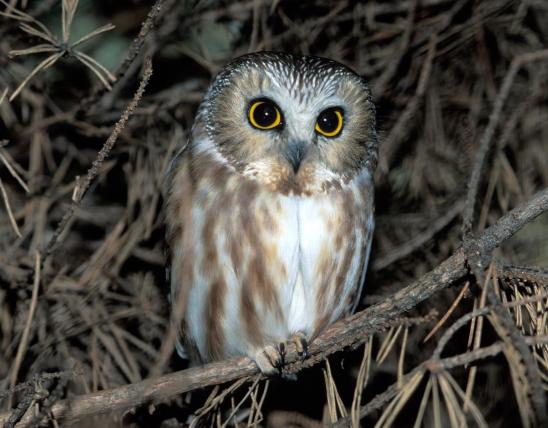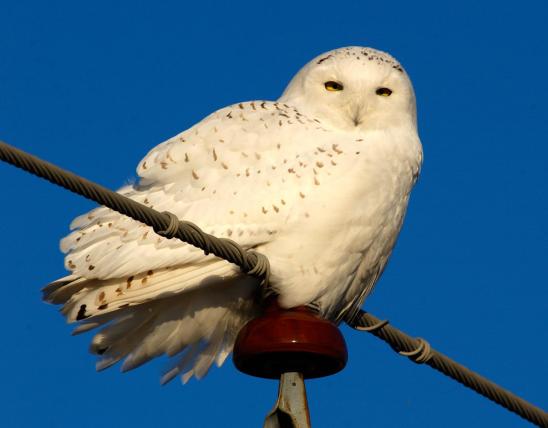
The long-eared owl is a slim owl, crow-sized, yellow-eyed, long-winged, without a white throat. Upperparts are gray-brown, underparts are heavily streaked and barred with dark brown. Facial disks are rusty, and the ear tufts are long and closely spaced. In flight, they have a buff patch in the upper side of the wing and a dark crescent at the bend of the wing's underside (this is similar to a short-eared owl, but not as prominent). Voice is a long "hooo," which may be repeated, or doglike barks and hoots, whines, and squealing sounds — although they are usually silent on their wintering grounds in Missouri.
Similar species: Great horned owls are larger, with shorter ears that are usually held at an angle, and with a large white throat patch. In Missouri, they are more common than long-eared owls. The short-eared owl has very short ear tufts that are difficult to see and is more likely to be seen on or near the ground and in grassy areas. Like the long-eared owl, it is not very common in Missouri.
Length: 15 inches (tip of bill to tip of tail); wingspan: 3 to 3½ feet.

Statewide.
Habitat and Conservation
Forests, pine plantations, and thickets in grasslands. This strictly nocturnal owl is highly secretive by day. Its flight is buoyant and mothlike. By day, long-eared owls roost in dense groves, especially in pines. Usually several are seen together, especially at roosts. To see long-eared owls, identify likely habitat and then look among the trees for owl pellets and droppings. These owls often sit on branches close to tree trunks, where their camouflaged feathers makes them hard to see.
Food
Hunts by night by flying low over grasslands and other open areas in search of prey, which include mice, rats, shrews, voles, and small rabbits.
Status
Uncommon (rare) winter resident. Casual (extremely rare) summer resident. A species of conservation concern in Missouri.
Life Cycle
Nesting in Missouri is extremely unlikely; there have been few reports within the past 20 years. This owl is present in Missouri from mid-November to mid-April. Breeding range in eastern North America is generally north of Missouri (the Dakotas, Minnesota, Wisconsin, along the Great Lakes, and into Canada). Nesting commences in March and April. Four to six eggs are laid in an old crow, hawk or squirrel nest, usually in pines. Incubation lasts 28 days, and the young fledge 34 days after hatching.
Human Connections
Owls have long been associated with wisdom and with superstitious omens. They are fascinating animals, in large part, because their nocturnal habits are hard for people to observe and understand. Naturalist Jonathan Evan Maslow's book "The Owl Papers" offers fascinating insights into owl-watching.
Ecosystem Connections
Since they don't build their own nests, long-eared owls require the nests of other species. They therefore depend on the presence of hawks, crows, ravens, and magpies for their reproductive success. Owls are excellent hunters of rodents, with the ability to fly silently and to zero in on their prey's location by hearing alone. Thus they contribute to keeping the potentially explosive populations of those mammals in check.




About 350 species of birds are likely to be seen in Missouri, though nearly 400 have been recorded within our borders. Most people know a bird when they see one — it has feathers, wings, and a bill. Birds are warm-blooded, and most species can fly. Many migrate hundreds or thousands of miles. Birds lay hard-shelled eggs (often in a nest), and the parents care for the young. Many communicate with songs and calls.




























